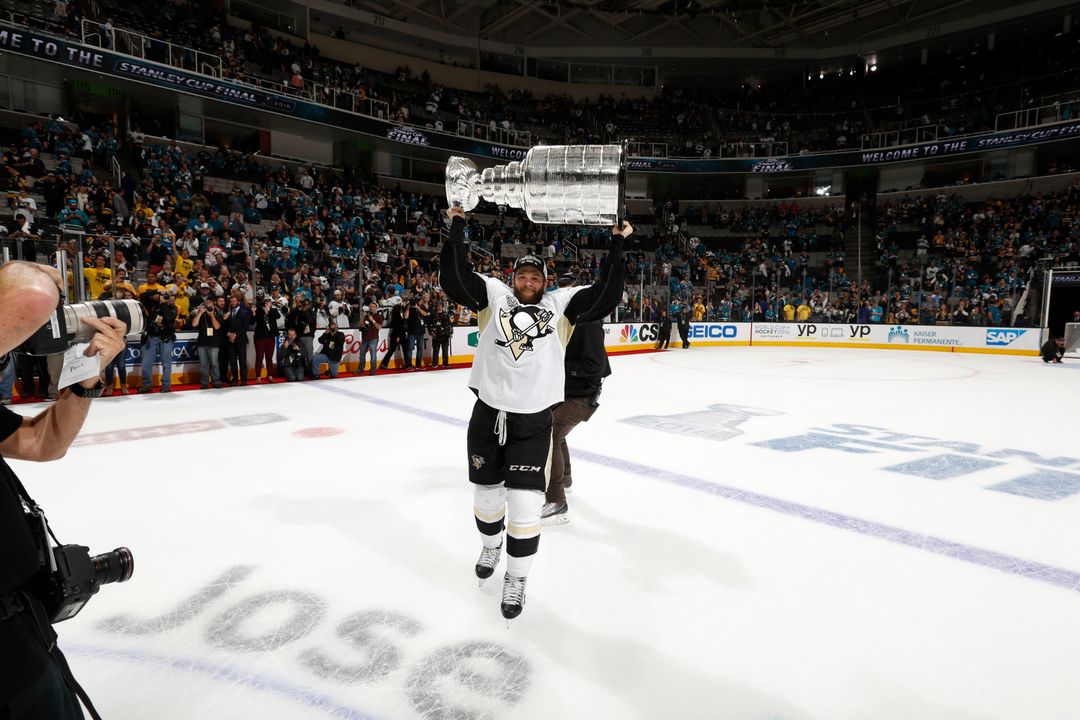Sept. 9, 2016
Cole, Rust Shine on Biggest Hockey Stage
By Sam Werner
As the clock expired in Game 6 of the NHL Stanley Cup final last June, Ian Cole found himself on the ice, standing next to his goalie, Matt Murray.
The puck was clear on the other side of the ice, and the Pittsburgh Penguins were just seconds away from claiming hockey’s ultimate prize. As soon as time expired, securing the Penguins’ 2016 Stanley Cup championship, Cole and fellow defenseman Ben Lovejoy were the first to embrace Murray and kick off the raucous celebration.
“It was a lot of fun,” Cole said. “Being able to grab Murray, grab Benny Lovejoy and have all the boys come out and start the dog-pile, it was really fun.”
Among those teammates who quickly joined them on the ice was winger Bryan Rust, who had broken a finger on his right hand earlier in the game and, truth be told, was a bit worried it might hinder his ability to lift the Stanley Cup, a dream every hockey player has from soon after they first lace up skates.
“I thought maybe for a second that it would [be difficult],” Rust said. “But when you first get it in your hands and throw it over your head, it feels weightless. It’s a 35-40 pound trophy, and at that point you’re lifting a piece of plywood over your head.”
With the Penguins’ championship, Cole and Rust became the first former University of Notre Dame hockey players to win the Stanley Cup since defenseman Mark Eaton did so with the Penguins in 2009.
Cole and Rust were the first two Irish players who played under current coach Jeff Jackson, who took over the program in 2015, to lift the Cup.
Cole, Rust and the Stanley Cup are on campus this weekend, and the two players will be recognized today at the Notre Dame-Nevada football game.
“It was the first time I had ever really focused on watching them lug the Cup around,” Jackson said. “It was nice. Especially the relationship you develop with guys like Ian and Bryan over the years. It’s fun to watch them realize that dream.”
For both Cole and Rust, the dream started at their childhood homes in Michigan and took them to Notre Dame–with a trip to the NCAA Frozen Four for each–before they reached the NHL.
Cole joined the Penguins in a trade from St. Louis last year, while Rust started this season with the team’s minor-league AHL affiliate in Wilkes-Barre, before being called up five games into the year.
“Pretty much any team in the league enters the season thinking, ‘Man, we’ve got a chance to make a run here,'” Cole said. “Did I think we’d finish it with the Stanley Cup? No, I didn’t think we would finish it with a Stanley Cup.”
Early results certainly didn’t look promising, as the Penguins struggled and changed coaches just two months into the season.
Rust spent those first few months bouncing between the AHL and NHL, and Cole was scratched from the lineup for 11 games in late January and early February.
“You kind of had to swallow your pride a little bit, come back and kind of do what made you successful in the first place,” Cole said.
As the calendar flipped to March, any early-season troubles seemed far in the past. Rust had solidified his place in the NHL, and Cole’s renewed focus on his defensive game led to more consistent playing time on the Penguins’ blue line.
That’s also when they began to realize this Penguins team was capable of something special.
“I think the beginning of March was when we started to win a lot of games and were playing really well,” Rust said. “We kind of carried that through the end of the regular season and throughout the playoffs.”
The Penguins won 15 of their final 17 games heading into the playoffs and then eliminated the New York Rangers and Washington Capitals in the first two rounds to advance to the Eastern Conference final against the Tampa Bay Lightning.
In the decisive Game 7 of that series, Rust wrote his name in Pittsburgh sports lore, scoring both goals in the Penguins’ 2-1 win that propelled them to the Stanley Cup final.
After the game ended, teammate Nick Bonino told Rust, “You’re a Pittsburgh legend now.”
“I had to take a step back and think about that for a second because I didn’t necessarily believe it,” Rust said. “In the moment, I was just trying to get the puck to the net, do everything I could to play well and help the team. Looking back at it, it’s something that I’m definitely never going to forget.”
Rust didn’t stop there, though, as he also scored the first goal in Game 1 of the Stanley Cup final against the San Jose Sharks, sending Consol Energy Center in Pittsburgh into a frenzy.
He admitted that, even three months later, he still gets chills thinking about it.
“It is different,” Rust said. “It’s probably the biggest stage a hockey player can be on. As a guy that hadn’t played very many games in the league, to be able to come out and score the first goal of the Stanley Cup final, see the reaction of the crowd and the team, it was something special.”
The Penguins won the first two games of the final at home, but dropped Game 3 in overtime in San Jose.
In the first period of Game 4, Cole joined Rust on the relatively short list of players to score a goal in the Stanley Cup final, putting the Penguins up 1-0 with his first goal of the season.
“In the Stanley Cup final, to get the ol’ goose egg off was great,” Cole said. “And obviously scoring the first goal in a playoff game is so important.”
The Penguins went on to win Game 4 by a 3-1 count and two games later claimed the fourth Stanley Cup in franchise history, allowing Cole and Rust to live the fantasy of every young hockey player.
“You skate around in your driveway and you think about,” Rust said. “You do it a thousand times as a kid, dreaming and hoping one day you can do it. To be able to really, actually do it, it’s an irreplaceable feeling.”
Their time with the Cup didn’t end there, though, as both took it back to their respective homes in Michigan this summer.
Rust took it golfing with his family, followed by a reception with old friends and more photos than he could count.
“I was taking a lot pictures, but those smiles were real,” he said.
Cole brought it home to Ann Arbor, going to old restaurants with high school friends and constantly telling people, yes, that is the real Stanley Cup.
“I usually like to fly under the radar, but it’s impossible when you’re walking around with the most recognizable trophy in sports,” he said.
He also took it to the Ronald McDonald House and Mott Children’s Hospital, where he even agreed to pose for pictures alongside a Michigan logo.
“I figured, ‘You know what, it’s for the kids. If the kids are happy, I’ll pose with the Block M every once in a while,'” Cole said with a laugh.
That afternoon, Cole hosted a party at his parents’ house, where Jackson and Irish assistants Paul Pooley and Andy Slaggert were among the attendees.
“Being able to invite them and share it with them, [Notre Dame] was a huge steppingstone for me as a player,” Cole said.
Cole actually committed to the Irish in 2005, when the team was coming off the worst season in program history and in the midst of a coaching transition.
“I committed there and people were like, ‘What are you doing? You could go anywhere else,'” Cole recalled.
Cole’s faith in Jackson–whom he had known since he was a child when Jackson was involved with the U.S. National Development Team in Ann Arbor–turned out to be well-founded.
As a freshman, Cole played a key role in leading Notre Dame to the first Frozen Four in school history, where the Irish beat Michigan in overtime in the semifinal before falling to Boston College in the NCAA Championship game.
“That’s really special to be a part of that group that turned the program around and put it on the map there, for hopefully a long time to come,” Cole said.
Cole left after three years, forgoing his senior season to turn pro but returned in the ensuing summers to finish his degree.
“To me, that’s a huge thing,” Jackson said. “I always tell these guys when they leave early, ‘You’ve got to promise me you’re going to come back and get your degree before you get my blessing before they leave early.'”
Rust arrived the year after Cole left, just as the program was starting to take that next step in building its history. He played his freshman year in the north dome of the Joyce Center before moving to Compton Family Ice Arena for the final three seasons.
Rust was part of the 12-man freshman class that arrived in 2010 and immediately led Notre Dame back to the Frozen Four in its first season.
“We were just coming in, trying to make our mark,” Rust said. “It was the same type of thing (in Pittsburgh), just having fun every day when we came to the rink.”
For Cole, Rust and the rest of the Penguins that fun ride this year culminated with a dog-pile on the ice at the SAP Center in San Jose.
While they may be the most recent former Irish players to hoist the Stanley Cup, there’s a good chance Cole and Rust will have some company in the coming years. They were two of six Notre Dame alumni playing in this year’s NHL playoffs, a number that is likely to grow in coming years.
“[It’s cool] to be kind of the new wave of Notre Dame players who came into the NHL and who have made their mark,” Rust said. “To be able to win the Cup as a representative of the school is something that’s really special, too.”
A 2011 Notre Dame graduate, Sam Werner covers the Penguins for the Pittsburgh Post-Gazette.








